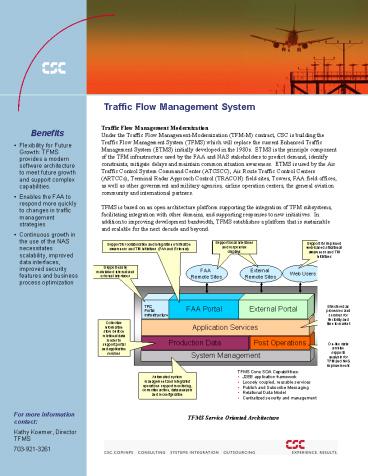Traffic Flow Management System - PowerPoint PPT Presentation
1 / 2
Title:
Traffic Flow Management System
Description:
... and military agencies, airline operation centers, the general ... the ability to rapidly adapt the traffic analysis and flow management has become critical. ... – PowerPoint PPT presentation
Number of Views:237
Avg rating:3.0/5.0
Title: Traffic Flow Management System
1
.
Traffic Flow Management System
Traffic Flow Management Modernization Under the
Traffic Flow Management-Modernization (TFM-M)
contract, CSC is building the Traffic Flow
Management System (TFMS) which will replace the
current Enhanced Traffic Management System (ETMS)
initially developed in the 1980s. ETMS is the
principle component of the TFM infrastructure
used by the FAA and NAS stakeholders to predict
demand, identify constraints, mitigate delays and
maintain common situation awareness. ETMS is
used by the Air Traffic Control System Command
Center (ATCSCC), Air Route Traffic Control
Centers (ARTCCs), Terminal Radar Approach Control
(TRACON) field sites, Towers, FAA field offices,
as well as other government and military
agencies, airline operation centers, the general
aviation community and international partners.
TFMS is based on an open architecture platform
supporting the integration of TFM subsystems,
facilitating integration with other domains, and
supporting responses to new initiatives. In
addition to improving development bandwidth, TFMS
establishes a platform that is sustainable and
scalable for the next decade and beyond.
- Benefits
- Flexibility for Future Growth TFMS provides a
modern software architecture to meet future
growth and support complex capabilities. - Enables the FAA to respond more quickly to
changes in traffic management strategies - Continuous growth in the use of the NAS
necessitates scalability, improved data
interfaces, improved security features and
business process optimization
For more information contact Kathy Koerner,
DirectorTFMS 703-921-3261
TFMS Service Oriented Architecture
2
The Total Flight Planning PackageDirect User
Access Terminal Service (DUATS)
- Advanced Technology System Integration
- With experience in approaches developed for
commercial use and proven in the Federal market,
CSC is capitalizing on advances in system
integration technology for TFMS. - TFMS employs a Service Oriented Architecture
(SOA) based on systems technologies that include
business process management, portals, XML-based
messaging, improved business rules execution, a
relational database, and reporting tools. The
modernized TFMS infrastructure will adhere to
open industry-driven standards such as the Java
2-Enterprise Edition (J2EE) suite and eXtensible
Markup Language (XML). - Modular services minimize the impact of changes
to the NAS by avoidance of internal function
tangling. TFMS accomplishes this by isolating
interfaces from processing components (including
system-to-system interfaces and human-computer
interfaces), isolating data management from
processing, and modularizing processing in
subsystems. - Leverage Lessons Learned
- The Traffic Flow Management System builds upon
lessons learned from ETMS and provides a modern,
state of the art technology for a scalable,
flexible, and open infrastructure to support the
evolving and expanding NAS. New capabilities to
be addressed once the modernization of
infrastructure is complete include improved
airspace management via more precise application
of initiatives, augmented data interfaces with
NAS systems to improve predictions, improved
assessment capabilities by allowing reroute
modeling which includes user preferences, and
improved performance measures which will provide
feedback for overall process improvement.
Modernized TFMS components will support all of
these initiatives, and set the stage for the
future. - Experience. Results.
- TFMS provides a modern software architecture to
meet future growth and support complex
capabilities not possible with the legacy system,
e.g., modeling the effects of candidate Traffic
Management Initiatives (TMI) on the National Air
Space (NAS) to help ensure the selection and
execution of the most efficient and equitable
alternative (see FAA Flight Plan Objective 2
Increase reliability and on-time performance of
scheduled carriers). - TFMS enables the FAA to respond more quickly to
changes in traffic management strategies. For
example, many operational procedures are based on
existing patterns of airspace use. With the
rapidly changing approaches to air traffic cost
improvement being developed by the airlines
(regional jets, etc.),
Innovation and Results from a Trusted Partner
- the ability to rapidly adapt the traffic analysis
and flow management has become critical.
Representing these operations with
computer-orchestrated services facilitates
controlled incremental - change.
- Continuous growth in the use of the NAS
necessitates scalability, improved data
interfaces, improved security features and
business process optimization. TFMS will support
and encourage enhancements and improvements,
utilizing a scalable, state-of-the-art service
based architecture to allow for optimized change
and growth. TFMS will also support research and
technology prototyping, facilitated by the
modernized infrastructure.































